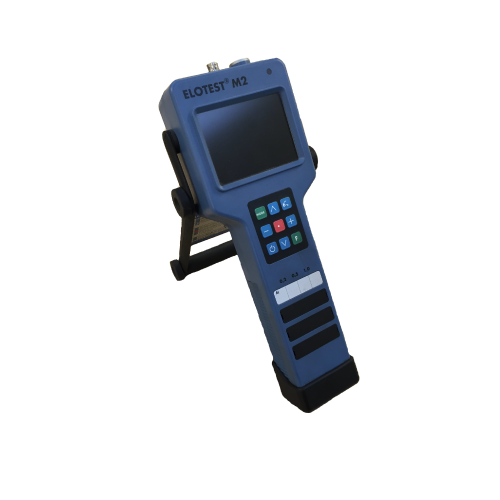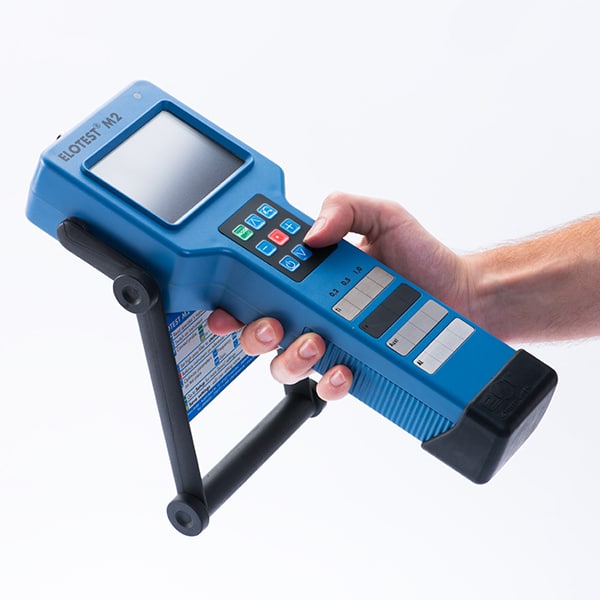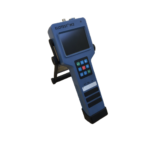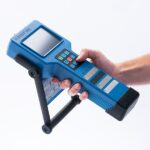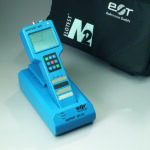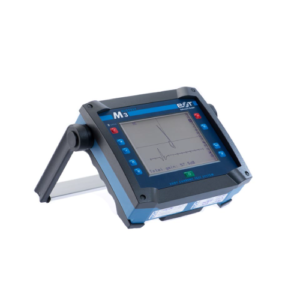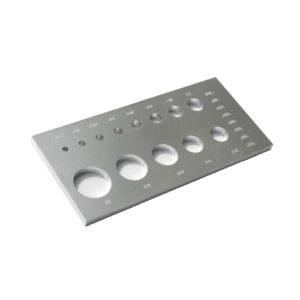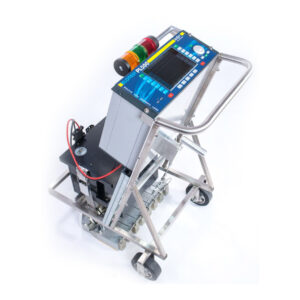Rohmann ELOTEST M2 V3 universeel wervelstroomapparaat voor oppervlakte scheurdetectie
De Rohmann ELOTEST M2 V3 is een universeel ‘one-hand’ test instrument voor oppervlakten, boorgaten en verborgen structuren. Tevens meet het instrument geleidbaarheid en laagdikte van alle materialen. De ELOTEST M2 beschikt over een DUAL-frequentie inspectie met een frequentiebereik van 10Hz tot 12MHz. Het biedt alle filter functies (LP, HP, BP) om het signaal te optimaliseren voor statische en dynamische inspecties. Het heldere LCD met LED-backlight werkt zelfs in direct zonlicht en voorzet optimale weergave van de testsignalen. Geïntegreerde referentie standaarden maken het werken on-site makkelijk en snel.
Het instrument is te bedienen via een gestructureerd keypad met een duidelijke toewijzing van de functies. Hierdoor kunnen zelf onervaren gebruikers het instrument gebruiken, snel en betrouwbaar. De gebruiksvriendelijkheid is tevens ondersteund door de duidelijke tekstweergave op het display.
De ELOTEST M2 V3 is geschikt voor alle soorten inspecties van hoogfrequente scheurdetectie op hooggelegeerde componenten tot middenfrequente scheur- en corrosietests laagfrequente testen van meerlaagse structuren voor stress scheuren.
Het dockingstation verandert het draagbare apparaat in een bench-top instrument met de connector voor pc of printer. Door het simpelweg aan te sluiten, wordt de intelligente laderelektronica geactiveerd en houdt het batterijpakket dat erin is geïntegreerd
het instrument op zijn optimale belastingsniveau.
> Download hier de Elotest M2 V3 brochure: M2_engl_2019
Technical Data
User-Interface ELOTEST M2 V3
– Pictograph-based, one-hand operation via key pad with key-click
– 6 languages: English, German, French, Italian, Swedish and Spanish
– Direct-function keys for offset- and liftoff-compensation
– Programmable function key
– Intuitive operation using only one submenu-level
Probe Connection
– 11-pin Fischer socket, compatible with the 8-pin Rohmann connector
– BNC connector for parametric probes (resonant probes)
– OEM probes to be connected via an adapter or directly to the BNC connector
– Speed control for rotor (torque compensated) in 10 steps
(corresponds to approx. 900 rpm to 2700 rpm using Rohmann standard rotors)
Active Probe Compensation
– Compensation of the probe response signal for optimum signal dynamics
– Automatic test frequency selection using the probe characteristics
– Automatic balancing of single-coil probes using finely graduated, internal compen- sating loads (no external elements required)
Frequency Range
– 10 Hz to 12 MHz, continuously adjustable, display in Hz, kHz, MHz
– Adjustable driver current, from 0 % to 100 % in 2 % steps
– Frequency variation from nominal less than 1 %; frequency stability 50 ppm
– Dual-frequency operation in multiplex-mode
Gain
– Preamplification 0 to 60 dB in 0.5 dB steps (0 to 40 dB in 100 kHz range)
– Gain 0 to 60 dB in 0.5 dB steps
– Axis spread 0 to 20 dB in 1 dB steps
– Automatic selection of preamplification and gain
Phase
– 0-359.5 in 0.5 steps; step size adjustable
Filter
– Low-pass filter 1.3 Hz to 10 kHz in 40 steps
– High-pass filter 0 Hz to 10 kHz in 40 steps
– Band-pass filter 0 Hz to 10 kHz; combination of HP and LP
– Selectable automatic filter for rotor operation
LCD–Display
– LCD featuring long-life LED backlight, 80 x 60 mm (3.15” x 2.36”)
– Temperature-compensated contrast setting
– Resolution 320 x 240 Pixel; refresh rate 75 Hz,
– 220,000 data samples/second, no signal delay
– Signal display covering 100 % of the screen; over 89 % with menu displayed
– 80 viewing angle
Display Modes
– Impedance plane / spot display (X/Y), available for all probes
– Time-base/sweep display (Y/t), 5 ms to 60 s in 17 steps; synchronized
– Simultaneous X/Y- and Y/t-display (dual-screen mode) – Reference signal may be displayed in the background – 2 screen grid sizes with adjustable intensity
– Selectable display range: X/Y center – X/Y center bottom – X/Y bottom right
– Freely positionable zero/null point
– Automatic trigger during rotor operation
– Simultaneous multi-signal display during multi-frequency operation
– Persistence: 0.1 s to 70 s adjustable in 12 steps
– On-screen signal storage; cleared manually or via auto-erase (2 – 80 s)
Gates/Alarm
– Alarm: optical and acoustic
– Active in all display modes; may be inverted
– Adjustable gates: +Y-gate, Box-gate, Circle-gate with adjustable flat in the Y-direction
Parameter Settings/Image Memory
– 99 user settings may be programmed, stored and recalled
– 50 application-related factory default settings (cannot be overwritten)
– 32 signal memories incl. parameter settings for documentation
– Parameter setups and images may be named using alphanumerical characters
– Image and parameter data may be printed and transmitted to personal computer
– Long-term recording (strip chart) of X- and Y-signals, from 20 s to 24 hours; 90,000 min/max-values (envelope, without data-loss)
– Data storage maintained (backup-battery)
Conductivity Measurement
– Measurement in % IACS or MS/m from 1 % IACS to 110 % IACS.
– Measuring frequencie: 60 kHz
– Calibration using 2 individually adjustable calibration points
Coating Thickness Measurement
– Measurement of non-conductive layers on conductive non-ferromagnetic materials
– Measurement range up to 1000 m or 40 mils
Multi-Frequency Operation
– 2-frequency multiplex
– Multiplex rate up to 1 kHz
– Both frequencies fully adjustable, independent of each other
– Signal mix-function to suppress unwanted effects
Interfaces
– RS232-interface for PC or printer (printer-types on request)
Operation with Lithium-Ion Batteries
– Without background light and rotor: approx. 8 hours
– With light and rotor: approx. 6 hours
– Indication of remaining charge capacity
– Acoustic and optical alarm for low battery
– Charge time Li-Ion battery from 0 % to 70 % – approx. 1 hour
– Charge time Li-Ion battery from 0 % to 100 % – approx. 6 hours
– Battery may be replaced in less than 10 seconds
Ambient Conditions
– Operation between -20 C (-4 F) and 50 C (122 F) at max. 85 % rel. humidity (non-condensating)
– Storage between -30 C (-22 F) and 80 C (176 F) at max. 85 % rel. humidity (non-condensating)
– Battery charge between 0 C (32 F) and 40 C (104 F) at max. 85 % rel. humidity (non-condensating)
Dimensions
– Ergonomic design
– Max. dimensions: 320 mm (12.6“) / 125 mm (4.92“) / 73 mm (2.87“) (length/width/depth)
– At display: 120 mm (4.72”) / 107 mm (4.21”) / 53 mm (2.08”) (length/width/depth)
– At handle: 185 mm (7.2”) / 63 mm (2.48”) / 44 mm (1.73”) (length/width/depth)
Weight
– Ergonomically optimized center of gravity (inside the operator‘s hand)
– Instrument without battery approx. 530 g (1.1 lbs)
– Lithium-ion battery approx. 390 g (0.85 lbs)
– Wide-range charger approx. 560 g (1.23 lbs)
– Table-top charger (docking station) approx. 1,070 g (2.35 lbs)
Power Supply (Options)
– Li-ion battery (14.8 V/2300 mAh)
– Mains operation with desk-top docking station (88 – 265 VAC/47 – 440 Hz) featuring intelligent battery management separately for instrument and second battery pack
Calibration Standards (optional)
– Calibration standards: titanium, aluminum, stainless and ferromagnetic
– steel with reference notches: 0.2/0.5/1.0 mm (0.039/0.02/0.008 inch) deep; may be inserted into the instrument handle
Setting Manager
– PC-software to archive settings, generate test reports and screen shots
Andere suggesties…
-
Rohmann ELOTEST M3 universeel wervelstroomapparaat voor oppervlakte scheurdetectie en geleidbaarheid % IACS
Lees meer -
Rohmann ELOTEST PL650 Universeel digitaal eddy current test instrument
Lees meer -
Rohmann ELOTEST B300 meerkanaals wervelstroomapparaat voor scheurdetectie en geleidbaarheid % IACS
Lees meer

